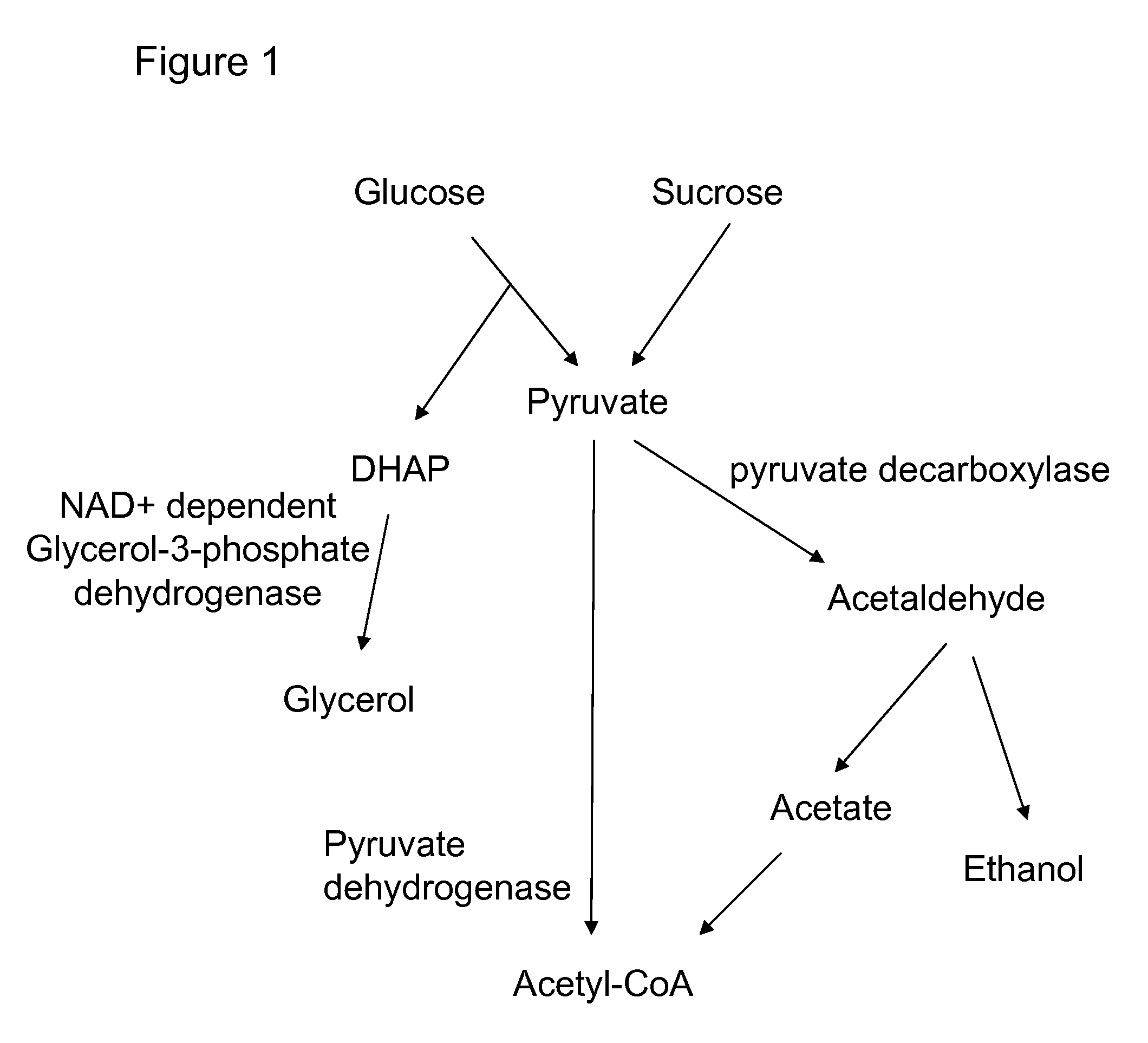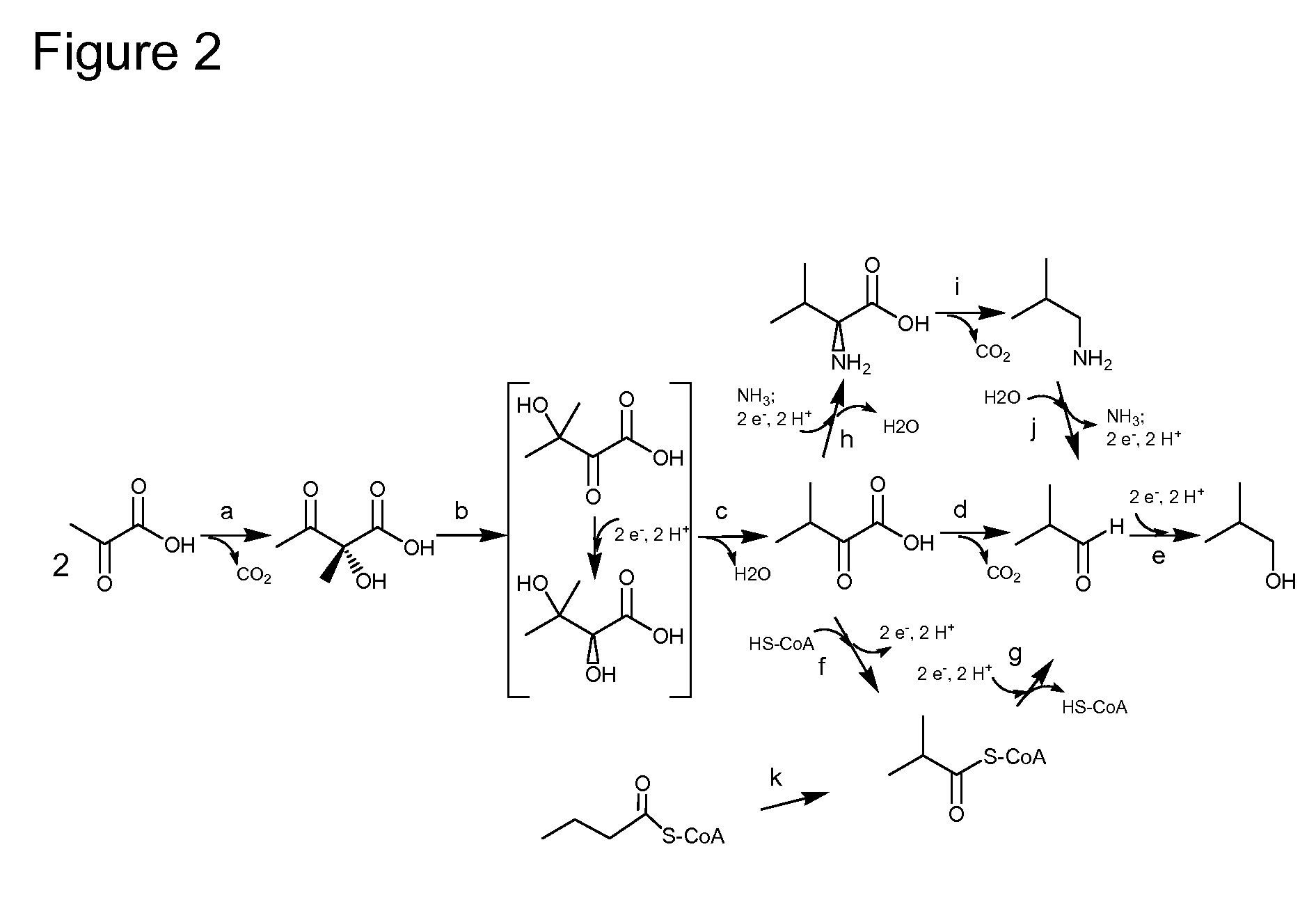Enhanced pyruvate to acetolactate conversion in yeast
a technology of pyruvate and acetolactate, which is applied in the direction of lyase, transferase, bulk chemical production, etc., can solve the problems of limited production of 2,3-butanediol, 2-butanone, 2-butanol and isobutanol in recombinant yeasts, and may limit the product formation of substrates, etc., to achieve high conversion of endogenous pyruvate, pyruvate decarbox
- Summary
- Abstract
- Description
- Claims
- Application Information
AI Technical Summary
Benefits of technology
Problems solved by technology
Method used
Image
Examples
example 1
Disruption of Pyruvate Decarboxylase Genes
[0166]The purpose of this example is to describe disruption of pyruvate decarboxylase genes in S. cerevisiae by chromosomal deletion of genes encoding the three major isozymes: PDC1, PDC5, and PDC6.
[0167]The PDC1 gene, encoding a first isozyme of pyruvate decarboxylase, was disrupted by insertion of a LEU2 marker cassette by homologous recombination, which completely removed the endogenous PDC1 coding sequence. The LEU2 marker in pRS425 (ATCC No. 77106) was PCR-amplified from plasmid DNA using Phusion DNA polymerase (New England Biolabs Inc., Beverly, Mass.; catalog no. F-540S) using primers PDC1::LEU2-F and PDC1::LEU2-R, given as SEQ ID NOs:102 and 103, which generated a 2.0 kb PCR product. The PDC1 portion of each primer was derived from the 5′ region upstream of the PDC1 promoter and 3′ region downstream of the transcriptional terminator, such that integration of the LEU2 marker results in replacement of the pdc1 coding region. The PCR pr...
example 2
Engineering S. cerevisiae Strains for Cytosolic Expression of Acetolactate Synthase and Deletion of Pyruvate Decarboxylase Genes
[0170]The purpose of this example is to describe the construction and introduction of acetolactate synthase genes for expression in the cytosol of a yeast strain that also has deletions of pyruvate decarboxylase genes PDC1 and PDC5. Two yeast promoters were independently used to control alsS gene expression—the glycolytic FBA promoter from the S. cerevisiae fructose 1,6-bisphosphate aldolase or the HIS3 promoter from the S. cerevisiae imidazoleglycerol-phosphate dehydratase gene.
[0171]Expression plasmid pRS426-FBAp-alsS was constructed via the following steps. The 1.7 kb alsS coding region fragment of pRS426::GPD::alsS::CYC was isolated by gel purification following BbvCI and PacI digestion. This plasmid has a chimeric gene containing the GPD1 promoter (SEQ ID NO:114), the alsS coding region from Bacillus subtilis (SEQ ID NO:3), and the CYC1 terminator (SEQ...
example 3
Vector Construction for the Production of Butanediol
[0175]The purpose of this example is to describe the construction of vectors for the expression of acetolactate decarboxylase, butanediol dehydrogenase, and, optionally, acetolactate synthase and / or secondary alcohol dehydrogenase activity in the cytosol of yeast.
Construction of pRS423::CUP1-alsS+FBA-budA
[0176]The budA gene, encoding acetolactate decarboxylase, was amplified from genomic DNA prepared from Klebsiella pneumonia (ATCC #25955) using Phusion™ Hot Start High-Fidelity DNA Polymerase (New England Biolabs, Inc.). The primers used (N579 and N580, provided as SEQ ID NOs:123 and 124) added sequence upstream of the start codon that was homologous to the yeast FBA promoter and sequence downstream of the stop codon that was homologous to the yeast ADH terminator. Plasmid pRS423::CUP1-alsS+FBA-ILV3, which has a chimeric gene containing the CUP1 promoter (SEQ ID NO:125), alsS coding region from Bacillus subtilis (SEQ ID NO:3), and ...
PUM
| Property | Measurement | Unit |
|---|---|---|
| temperature | aaaaa | aaaaa |
| temperature | aaaaa | aaaaa |
| temperature | aaaaa | aaaaa |
Abstract
Description
Claims
Application Information
 Login to View More
Login to View More - R&D
- Intellectual Property
- Life Sciences
- Materials
- Tech Scout
- Unparalleled Data Quality
- Higher Quality Content
- 60% Fewer Hallucinations
Browse by: Latest US Patents, China's latest patents, Technical Efficacy Thesaurus, Application Domain, Technology Topic, Popular Technical Reports.
© 2025 PatSnap. All rights reserved.Legal|Privacy policy|Modern Slavery Act Transparency Statement|Sitemap|About US| Contact US: help@patsnap.com



